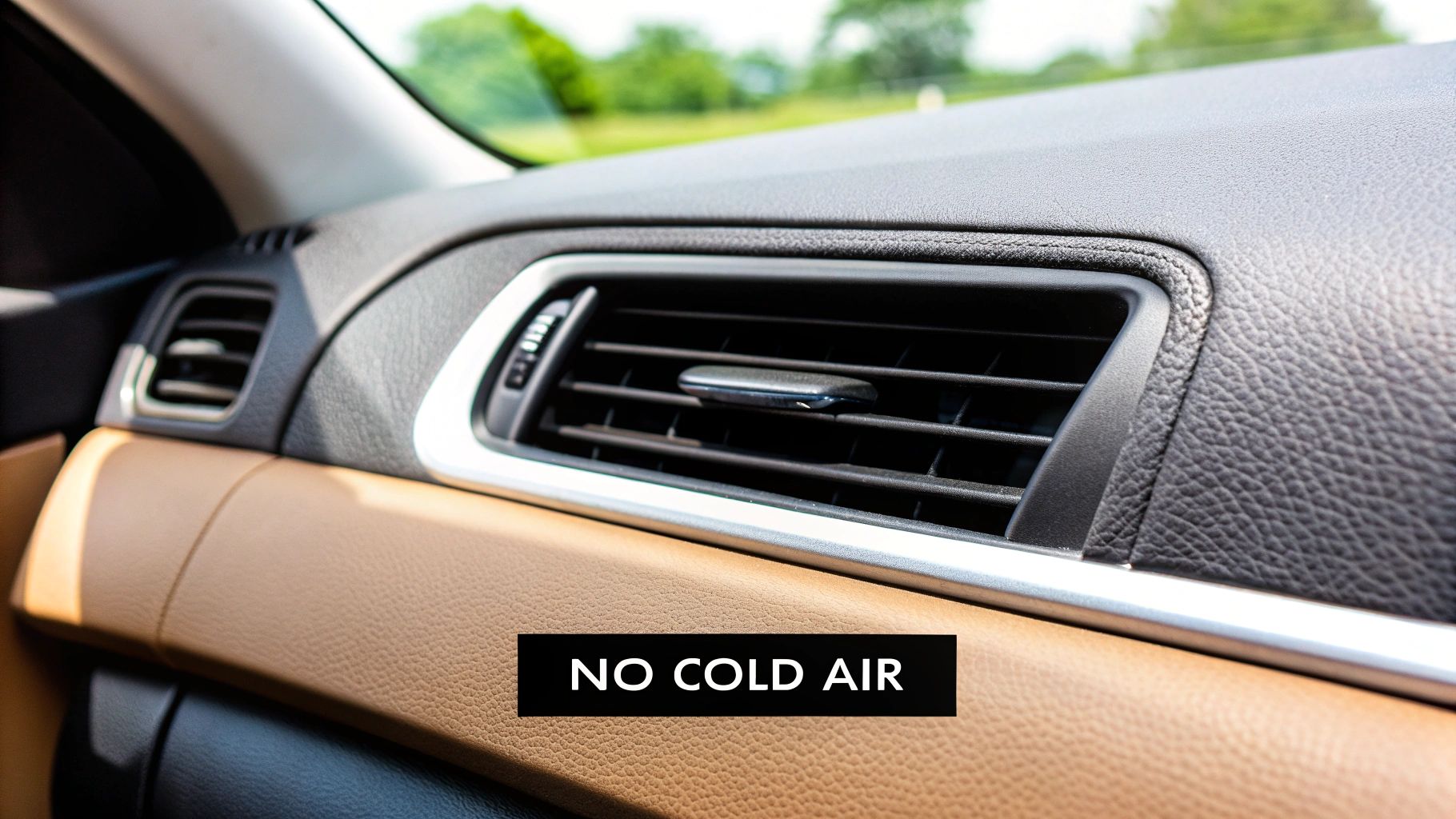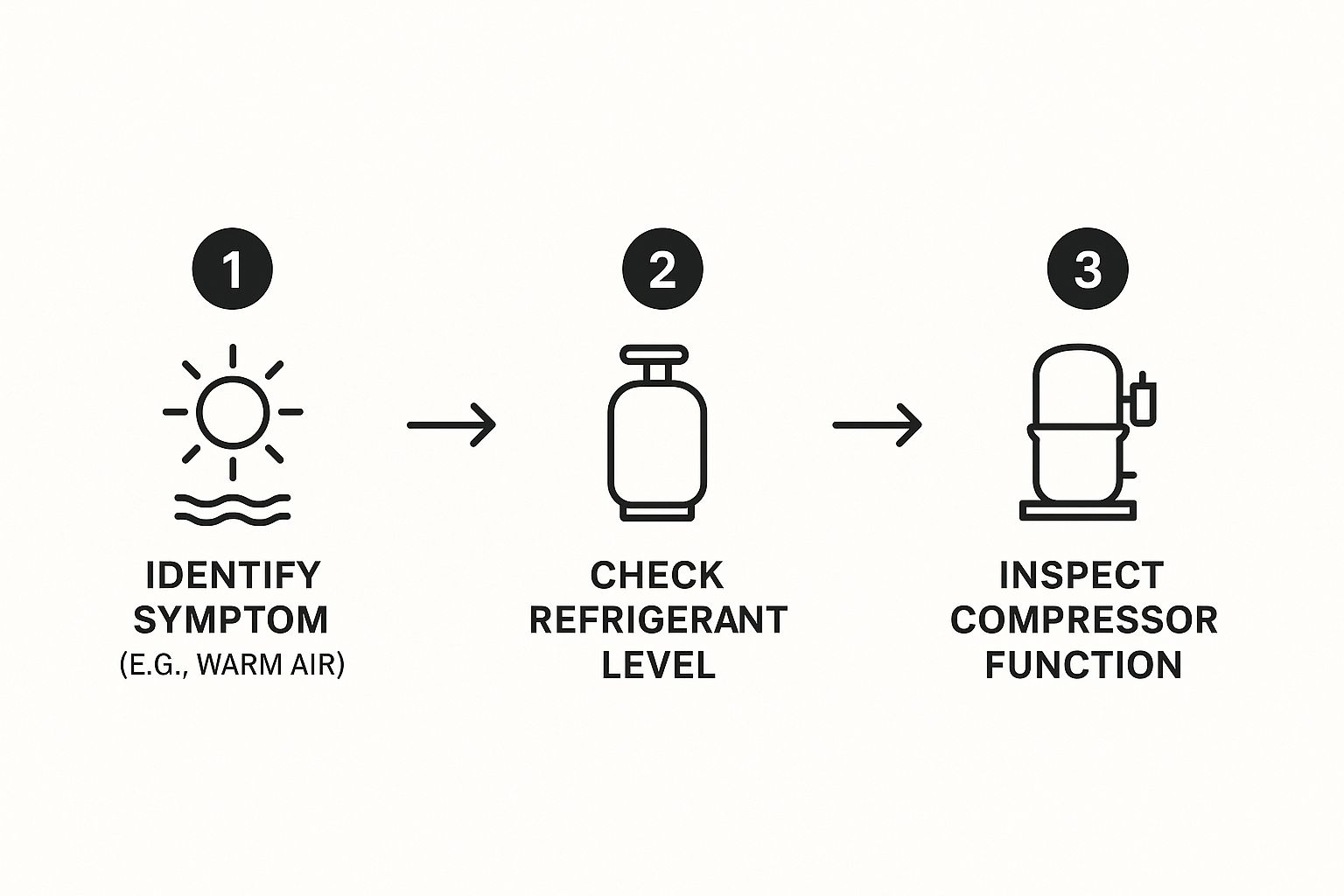Fixing Car Air Conditioning Problems: A UK Guide
- coledem
- Aug 7
- 13 min read
When your car's air conditioning starts blowing warm air, it is a real pain, especially on a sweltering day. Usually, the culprit is one of three things: low refrigerant, a faulty compressor, or a blocked condenser. The first step is to pinpoint the exact symptom, which will lead you straight to the right fix and get that cool, refreshing breeze back.
Getting to Grips with Common Car Air Conditioning Problems
A failing car air conditioning system can make any drive miserable, particularly during a heatwave. Knowing what is going on behind the dashboard helps you connect the symptoms to their likely causes, giving you a solid starting point for a repair. With a bit of know-how, you can often make a good initial diagnosis yourself.
Let's start with the most common complaint: the air just is not cold. More often than not, this points to a refrigerant issue. Your car’s AC is a sealed system, so if the refrigerant level drops, it simply cannot cool the air effectively. This drop is almost always down to a leak somewhere in the system—be it a hose, a seal, or another component.
Matching Symptoms to Their Causes
Strange sounds and smells can also be big clues. If you hear a rattling or buzzing noise when you switch the AC on, your attention should turn to the compressor. That is the heart of the system, responsible for circulating the refrigerant. A musty, damp smell coming from the vents is a classic sign of mould or bacteria building up on the evaporator core.
Weak airflow is another frequent problem. You can hear the fan blowing its heart out, but only a trickle of air is making it through the vents. This is usually caused by a clogged cabin air filter. Think of it as the lungs of your car's interior; it gets blocked up with dust, leaves, and all sorts of road gunk, which chokes off the air.
A working AC system is not just about comfort; it is a genuine safety feature. It is needed for demisting your windscreen in damp weather for clear visibility and helps reduce driver fatigue on long, hot journeys.
To help you quickly figure out what might be wrong, here's a table that connects common symptoms with their most likely causes.
Common AC Problems and Their Likely Causes
Symptom | Most Likely Cause | Recommended Action |
|---|---|---|
Air is not cold or is only slightly cool | Low refrigerant from a leak | Check for leaks and recharge the system with a DIY kit or visit a professional. |
Weak airflow from vents | Clogged cabin air filter | Replace the cabin air filter—an easy and inexpensive DIY job. |
Musty or unpleasant smell | Mould/bacteria on the evaporator core | Use an anti-bacterial treatment spray for AC systems or have the system professionally cleaned. |
Rattling, buzzing, or squealing noise when AC is on | Failing AC compressor or clutch | This is usually a job for a mechanic. Turn off the AC to prevent further damage. |
This table should give you a good starting point for your diagnosis. Once you have an idea of the cause, you can decide whether it's something you can tackle yourself or if it's time to call in the experts.
Why Your AC Matters More Than Ever
The need for a reliable car air conditioning system here in the UK has become more obvious as our climate changes. UK summers are getting consistently warmer, with recent years smashing temperature records. Data shows that temperatures have been climbing by roughly 0.25°C per decade. This makes a working AC critical from late spring right through to early autumn.
You can learn more about the rising importance of car AC from expert sources. It's no surprise that today, almost all new cars sold in the UK come with air conditioning as standard. This guide is here to help you sort out the most common car air conditioning problems, from simple fixes you can do on your driveway to knowing when it is best to hand the keys over to a professional.
How To Diagnose AC System Faults Yourself

Before you even think about booking your car into a garage, there are a few simple checks you can do right on your driveway. A bit of basic detective work can often point you straight to the heart of your car's air conditioning problems, saving you time and maybe even a diagnostic fee. You do not need any fancy tools for this first pass—just your eyes and ears.
Start the car and crank the AC to its coldest setting on full blast. Now, pop the bonnet and have a look at the AC compressor. Listen for a solid 'click' when it is meant to kick in. You should see the centre part of its pulley start spinning along with the belt. If nothing happens—no click, no spin—it's a big clue. It could be an electrical fault, or it might mean the refrigerant is so low the system's safety switch is preventing the compressor from engaging.
Visual Checks You Can Perform
A good old-fashioned look around the engine bay can tell you a surprising amount. Trace the AC pipes and have a close look at all the connections. What you're searching for is any kind of oily, grimy residue. The refrigerant itself is a gas and invisible, but it's mixed with a special lubricant oil. When there is a leak, this oil seeps out and attracts dirt, creating a tell-tale greasy patch right at the source of the problem.
Another part to inspect is the condenser. You'll find it right at the front of the car, usually mounted just ahead of the main engine radiator, and it looks quite similar. Its job is to get rid of the heat from the refrigerant, but its location makes it a prime target for damage.
Check for Blockages: Are the fins clogged with leaves, insects, or general road muck? A blocked condenser cannot do its job properly, which seriously hampers your AC's cooling power.
Inspect for Damage: Look closely for bent fins or any signs of impact from stones kicked up on the road. This kind of damage is a common cause of leaks.
After the recent UK heatwaves, garages everywhere have been swamped with AC repair jobs. That intense, prolonged use puts a massive strain on the system, often highlighting weaknesses in components like the compressor, which can fail from leaks or poor lubrication. Condensers also take a beating, becoming less effective when they're clogged with debris or start to corrode. Industry experts have noted this seasonal surge, and you can read more from Valeo on garagewire.co.uk.
Listening for Clues
Do not underestimate what your ears can tell you. With the engine running, try switching the AC on and off a few times while you listen from outside the car. Different noises can point to very specific faults.
If you hear a rattling or grinding sound that only starts when the compressor kicks in, the clutch assembly is likely on its way out. A high-pitched squeal that changes with engine speed often points to a worn or slipping serpentine belt, the very belt that drives the compressor.
These simple checks will not fix the issue, but they arm you with information. Walking into a garage and saying, "The AC is not working, and I think the compressor clutch is not engaging," is a world away from just saying, "The air con's broken." For more on figuring out what's wrong with your vehicle, our guide on car diagnostic checks for UK drivers is a great next step. It'll help you decide whether to tackle it yourself or hand it over to the pros.
A Practical Guide to DIY Refrigerant Recharging
If your car's air conditioning is blowing lukewarm air, the culprit is almost always low refrigerant. It's one of the most common issues we see. For anyone with a bit of DIY confidence, tackling a refrigerant recharge yourself can be a satisfying and wallet-friendly solution. It is a job you can handle.
You need to know which refrigerant your car uses. Modern cars use one of two types. If your car was made before 2017, it likely uses R134a. Newer models have almost all switched over to a more environmentally sound gas called R1234yf.
You can usually find this information on a sticker under the bonnet – have a look near the radiator or on the AC compressor itself. Getting this right is critical; using the wrong type can cause serious, expensive damage.
This handy image walks you through a quick diagnostic check before you jump straight to a recharge.

As you can see, it's a logical flow: check the symptom, then the refrigerant level, and finally the compressor itself.
Safely Adding Refrigerant
Once you have the correct kit, safety becomes your number one priority. Always wear safety goggles and gloves. Refrigerant can cause nasty skin and eye irritation if it gets on you. It is also needed to work in a well-ventilated space – an open garage door or your driveway is perfect. Never do this in a closed garage.
The recharge process itself involves hooking up the charging hose to the low-pressure service port. Your car has two of these ports (high and low), but a DIY kit is cleverly designed to only fit the correct low-pressure one. Look for a blue or black cap to identify it.
With the engine on and the AC cranked to its highest setting, connect the gauge from your kit. You'll add the refrigerant in short, controlled bursts of about 5-10 seconds at a time. After each burst, stop and check the pressure. This deliberate process stops you from overcharging the system, which can cause just as many problems as having too little refrigerant.
You're aiming for the pressure range specified in your kit's instructions, which is typically between 25-45 PSI, though this can vary with the outside air temperature. The goal is to get that needle into the "green" zone on the gauge without pushing it past.
Common Pitfalls for First-Timers
A classic rookie mistake is just topping up the refrigerant without asking why it was low. Your AC is a sealed system, so if it's low on gas, that almost certainly means there's a leak somewhere.
While a DIY recharge kit will get your cold air back for a while, think of it as a temporary fix if you do not address the underlying leak. Many kits do come with a leak sealer, which can work wonders on very small, slow leaks.
If you run into trouble or feel out of your depth, this easy step-by-step guide on how to fix car air conditioning has more detailed advice that can help you decide if it's time to call in a professional. A successful recharge feels great, but keeping an eye on the performance will tell you if a more permanent repair is needed down the line.
Tackling Bad Smells And Weak Airflow

Sometimes your AC is blowing cold, but it is still making your journey miserable. Two of the most common complaints I hear are nasty odours and a pathetic lack of airflow from the vents. Both point to specific problems that, thankfully, you can often sort out yourself with minimal fuss and cost.
If you are hit with a musty, damp smell—a bit like dirty socks—you have likely got mould and bacteria having a party in your AC system. This is a classic symptom. Moisture naturally collects on the evaporator core, which is hidden away behind the dashboard. Because it is dark and damp in there, it becomes a perfect breeding ground for all sorts of microbes, which then get blown straight into the car with the air.
Getting Rid Of Nasty Odours
You can clear this up pretty easily with a specialised anti-bacterial AC cleaner. These usually come in an aerosol can, often called an "AC bomb" or sanitising spray. They are designed to be released inside your car and circulate through the whole system, killing off the bacteria and mould causing the smell.
Here is the general idea of how they work:
Fire up the engine and get the air con running on its coldest setting.
Crank the fan up to maximum speed and make sure you have selected the recirculation mode.
With the windows and doors shut, set off the aerosol can inside the cabin.
Get out, shut the door, and let it do its thing for about 10-15 minutes (check the can for exact instructions). The mist will get sucked into the system and clean everything out.
A single treatment is often enough to completely banish the smells and make your car's air feel fresh again. For more proactive tips, have a look at our guide on essential car air conditioning care for 2025.
Fixing Weak Airflow
What if the fan sounds like it is working overtime, but you are only getting a weak whisper of air from the vents? Nine times out of ten, the culprit is a clogged cabin air filter. Its job is to stop dust, pollen, leaves, and other gunk from getting into the cabin. Naturally, after a while, it gets choked with debris.
A blocked filter does more than just weaken airflow. It puts a huge strain on the blower motor, which can lead to it burning out. It also cripples your AC’s cooling ability, since not enough air is passing over the cold evaporator to cool down.
Think of it like a vacuum cleaner with a full bag. The motor whirs away, but there's no suction because the air cannot get through. It's the exact same principle with your car's AC.
Luckily, swapping the filter is usually a quick job. Most are tucked away behind the glove box, and you can get to them by simply unclipping the compartment. Some models might have it under the dashboard or in the engine bay near the windscreen. A quick online search for your car’s make and model will pinpoint the location. It's one of the simplest and most satisfying DIY fixes you can do.
When to Call in the Professionals

While it is satisfying to sort out some car air conditioning issues on your own, it is just as important to know when to put the tools down. Some problems are simply too complex for a driveway fix and need the experience—and specialised equipment—of a qualified mechanic. Making that call at the right time can save you a lot of hassle and protect your car from further damage.
A major refrigerant leak is a classic example. If you have just topped up the system with a DIY kit and it's blowing warm air again within a few days, you have got a leak that's beyond a simple top-up. A professional will not just guess; they'll use tools like UV dye and electronic "sniffers" to trace the leak to its exact source, whether it is a tiny pinhole in a hose or a faulty seal.
Telltale Signs You Need an Expert
One of the most obvious red flags is a failing or seized AC compressor. If you switch on the air con and are met with a horrible grinding or screeching sound, that's your cue. The same goes if the compressor clutch refuses to engage at all. This points to a serious mechanical failure, and trying to fix it without the right know-how can cause a cascade of expensive problems.
You should also hand over the keys for any electrical issues. If the AC controls are acting up, or you find yourself replacing the same fuse over and over, there's likely a short circuit or a faulty sensor somewhere in the system. Tracing these electrical gremlins requires diagnostic scanners that can read fault codes directly from your car's computer—something most DIYers do not have in their toolbox.
Here are the big three signs you need a pro:
Serious Refrigerant Leaks: When a recharge only lasts a few days, a professional is needed to find and seal the leak properly.
Failing AC Compressor: Any loud, metallic noises are a dead giveaway that a major component has failed.
Recurring Electrical Faults: Unpredictable controls or constantly blowing fuses point to complex issues requiring diagnostic tools.
Professional garages have equipment that is just not practical for home use. A prime example is a vacuum pump, which is used to pull every last bit of old refrigerant, air, and moisture out of the system. This step is critical for making sure the new refrigerant works efficiently and prevents internal corrosion.
What to Expect From Professional Repair Costs
Let's be honest, the decision to call a mechanic often comes down to money. For UK drivers, the cost of professional air con repairs can be a real concern, and prices vary significantly. Looking at 2025 figures, the average repair cost in the UK hovers around £440.
This can be as little as £20 for a quick filter clean or climb to over £1,000 for a major job like replacing the compressor. The silver lining is that most common repairs can be sorted within 24 hours.
Opting for a qualified technician provides clear advantages. You get an accurate diagnosis, which stops you from throwing money away on parts you do not actually need. Plus, and this is a big one, professional work usually comes with a warranty covering both parts and labour, giving you valuable peace of mind. For a more detailed look, check out our guide on the costs of car air conditioning service in the UK.
Your Car AC Questions Answered
Even after a bit of troubleshooting, it is natural to still have some lingering questions about your car's air conditioning. Let's clear up a few of the most common things UK drivers ask about, covering everything from maintenance schedules to legal responsibilities.
How Often Should My Car AC Be Serviced?
Unlike an oil change, there is not a rigid manufacturer-mandated schedule for your air con. A great rule of thumb, though, is to get the system professionally checked every two years. This is not just a quick look-over; a proper service involves checking performance, topping up the refrigerant, and giving the system a deep anti-bacterial clean. Staying on top of this can stop minor issues from turning into expensive car air conditioning problems.
If you rely on your AC a lot, or if your car is getting on a bit, stepping that up to an annual check is a smart move. This proactive care ensures the system pressure is correct, which keeps all the components properly lubricated and running smoothly.
Does Using My Air Con Really Affect Fuel Economy?
Yes, it does, but maybe not as much as you think. When you turn the AC on, the engine has to put in a little extra work to drive the compressor. This additional load can increase your fuel consumption by roughly 3% to 10%.
You'll notice the impact most when you are driving around town, with all the stopping and starting. Once you are on the motorway, it is often more fuel-efficient to use the AC. At high speeds, the wind resistance from open windows creates so much drag that it can use more fuel than the air con system itself.
It is a myth that running the AC puts your transmission at immediate risk. Modern engines are built to handle the small extra load without any fuss. The main impact you'll see is at the fuel pump, not on your car's mechanical health.
Is It Legal To Do a DIY Refrigerant Recharge in the UK?
This is a really common question, and the answer depends entirely on your car.
In the UK, you can buy a DIY refrigerant recharge kit and top up the system yourself, but only if your car uses the older R134a gas. These kits are easy to find and are designed for car owners to use safely.
For newer cars (typically built from 2017 onwards) that use the more environmentally friendly R1234yf refrigerant, the law is very different. This gas is considered mildly flammable, so handling it is restricted. You are legally required to have a qualified, F-Gas certified technician do any work on these systems.
R134a Systems: DIY top-up kits are legal and widely available for personal use.
R1234yf Systems: All servicing must be performed by a certified professional.
Before you buy anything, pop the bonnet and find the sticker that specifies which refrigerant your car uses. Using the wrong type is a serious safety risk and can cause major damage to your AC system.
If you're dealing with stubborn car air conditioning problems or just want a professional service you can rely on, Krause Autos is here to help. Our skilled technicians in Sandy offer honest diagnostics and trustworthy repairs for drivers throughout Bedfordshire. Book your free AC performance check today at https://www.krauseautos.co.uk.





Comments